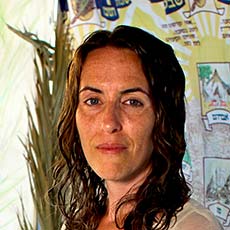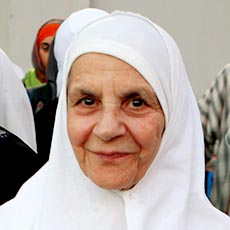About Sacred Journeys
For as long as humans have been humans, we have traveled the world in search of spiritual understanding. And to get closer to our gods.
Today, religion is more threatened than ever, yet sacred journeys are more popular than ever. 200 million people go on a pilgrimage each year. They set out from the ordinary, and seek the extraordinary.
SACRED JOURNEYS WITH BRUCE FEILER takes viewers on some of the most celebrated, challenging and spectacular religious pilgrimages on earth. In this landmark six-part series, we travel with American pilgrims looking to transform their lives as they visit places deeply meaningful to their faith. And our cameras gain privileged access to places rarely seen by viewers before.
A pilgrimage at its core is a gesture of action. Pilgrims feel a deeper connection to their faith. They feel closer to God. In a world in which more and more things are digital and ephemeral, a sacred journey gives the pilgrim the chance to experience something real.
Pilgrimage today is more alive than ever before. But you can't experience its wonders unless you go.
The Journeys
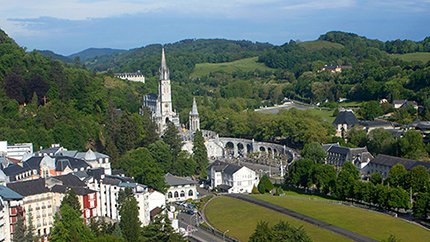
Lourdes
Premiered December 16 at 8/7C

Shikoku
Premiered December 16 at 9/8C
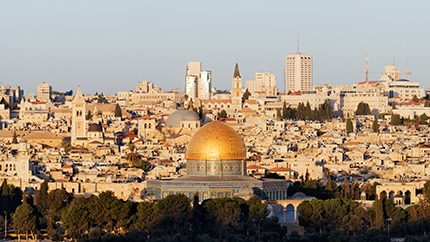
Jerusalem
Premiered December 23 at 8/7C
Host Bruce Feiler embeds with a group of active duty and retired US military, wounded in Afghanistan, Iraq and other American wars, as they travel to the Catholic shrine of Lourdes in Southwest France in search of healing. More than five million pilgrims from around the world visit this shrine to the Virgin Mary every year to drink and bathe in the waters of a spring that Catholics believe has miraculous powers.
The wounded warriors from America are joining 25,000 other military and their families from 35 different nations on an International Military Pilgrimage that's now in its 55th year, starting after the Second World War. While only half the American soldiers are Catholic, all hope that Lourdes can provide spiritual and emotional healing beyond the treatment they've already received for their physical wounds and disabilities—especially for invisible wounds of war like PTSD.
Some of these wounded warriors come to Lourdes as skeptics, many with faith or at least an open mind. Whether sharing their stories of war and recovery with Bruce Feiler or finding healing in the camaraderie of fellow warriors, the weeklong pilgrimage allows the veterans to open up to others in a place whose primary focus is to ease suffering. It's healing just as powerful as the waters of the spring uncovered by a young peasant girl named Bernadette during her vision of the Virgin Mary in 1858. Not everyone believes in miracles, but as a young non-Catholic soldier wounded just months earlier in Afghanistan says on his departure from Lourdes: "I don't know what it is but there's something special about this place."
The Island of Shikoku in Japan is the birthplace of the most revered figure in Japanese Buddhism, the monk and teacher Kobo Daishi, who brought a populist form of Buddhism to Japan from China in the 9th Century. For hundreds of years, a 750-mile pilgrimage route has circled this mountainous island, connecting 88 separate temples and shrines that claim connection to the Great Master—Kobo Daishi.
Host Bruce Feiler circles the island, following a pilgrim trail that's taken by hundreds of thousands of Japanese and international pilgrims every year; a Buddhist pilgrimage that welcomes pilgrims of all faiths. While the majority now drive or travel by train or bus—a two-week journey—many still set aside 60 or more days to walk the entire route, especially in the spring when the cherry blossoms are in bloom and pilgrimage season is at its height.
Temple priests introduce Bruce to sacred ceremonies that date back thousands of years, revealing how the presence of Kobo Daishi is believed to accompany all who follow in his footsteps. Out on the pilgrim trail, Bruce meets with different American walkers—a hiking group from the Pacific Northwest, a retired soldier from California, and two recently married doctors from Indiana—to learn why they've come to Shikoku and what they are hoping to find.
Sukkot, or the Feast of the Tabernacles, is one of three great festivals in the Jewish calendar when, in ancient times, Jews from across Israel were commanded to come to the Temple in Jerusalem on pilgrimage. But although Jewish pilgrimage lessened in importance after the destruction of the Temple by the Romans in 70 AD, Christian pilgrims began coming to Jerusalem and the Holy Land within centuries of Jesus' death.
During the week of Sukkot, host Bruce Feiler travels to Israel with Jewish and Christian pilgrims. For many Christians, the road to Jerusalem begins in the Galilee along the Jesus Trail, a route that follows the path of Jesus' ministry. For a Jewish pilgrim from Philadelphia, spending Sukkot in Jerusalem not only honors ancient Jewish pilgrimage but also her personal time of decision, whether to remain in America or move to Jerusalem on permanent pilgrimage.
In coming to Jerusalem, Bruce returns to his own Jewish roots. Whether walking with Christian pilgrims on the Jesus Trail, celebrating Sukkot with American Jews in Jerusalem or exploring the past with scholars of the three faiths— Judaism, Christianity and Islam—who share Jerusalem, Bruce reveals a land where religious and historical divisions have made it the most contentious place on earth. But as the pilgrims from different faiths converge on the many sacred shrines that coexist within Jerusalem's ancient walls, Bruce also reveals why Jerusalem has been a center of pilgrimage for so long. In spite of its long and turbulent history, it remains a city of faith for all who worship the One God who is the God of Moses, of Jesus and of Muhammad.

The Hajj
Premiered December 23 at 9/8C
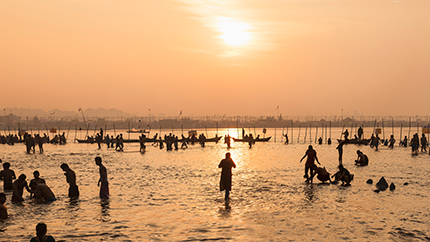
Kumbh Mela
Premiered December 30 at 8/7C

Osun-Osogbo
Premiered December 30 at 9/8C
"The Hajj is the iconic pilgrimage on Earth," says host Bruce Feiler, as millions of pilgrims gather in the valleys outside the city of Mecca in today's Saudi Arabia to take part in the annual five-day pilgrimage every Muslim hopes to complete at least once. Since non-Muslims aren't permitted in Mecca, Bruce's surrogate is Anisa Mehdi, a veteran reporter of the Hajj, with whom Bruce will Skype at regular intervals. Anisa joins a group of Muslim pilgrims from Boston who begin their journey in Medina, the second of Islam's holy cities.
As the pilgrims visit sites in Medina associated with the life of the Prophet Muhammad, Bruce enlists the help of a historian and an eminent American Muslim scholar to explore the origins of the religion and its iconic pilgrimage. In 622CE Muhammad fled his birthplace of Mecca after persecution by its pagan rulers who objected to him preaching a new monotheism. Muhammad and a small group of followers settled in Medina. Within ten years Islam was the dominant religion of Arabia and Muhammad returned to Mecca in triumph to clear idols from the holy sites and teach his followers the different stages of the Hajj pilgrimage.
The Boston pilgrims follow Muhammad's path from Medina to Mecca, beginning their Hajj by circling the Ka'aba, the ancient shrine at the center of Mecca's Great Mosque. Muslims believe the Ka'aba was first built by Abraham, patriarch of Islam, Judaism and Christianity. Stripping themselves of worldly possessions for the duration of the Hajj, the pilgrims enact the rituals laid out by Muhammad, experiencing exhaustion, injury and elation as they seek forgiveness and inner peace. They leave with a new sense of connection to humanity, and to the one-and-a-half billion people that make up the worldwide community of Muslims.
Every twelve years, tens of millions of men, women and children gather on the flood plain of the Ganges and Yamuna Rivers in Allahabad, India, for the largest gathering of humanity for religious purposes on the planet, and host Bruce Feiler is there. This is the Kumbh Mela, the great Hindu festival where pilgrims come from across India, and around the world, to bathe in the water where two sacred rivers meet. Such mass bathing in the Ganges has been recorded for two thousand years, and at least 100 million people will attend what Hindu astrologers have declared as the most auspicious Kumbh Mela in 144 years.
Host Bruce Feiler travels to the Kumbh with a group of spiritual seekers from across America, first stopping in the Hindu holy city of Varanasi, downstream from Allahabad, to take part in traditional rituals on the Ganges, India's most sacred river that is worshipped by Hindus as a goddess. Bruce and the pilgrims travel on by bus to the vast Mela tent city built on land that was underwater just months earlier and will be flooded again in just a few months more. Bruce and the American pilgrims settle into camp, surrounded by millions of other pilgrims, holy men, gurus and ash-covered Naga babas, the naked ascetics who are the most visible symbol of the Kumbh Mela.
After surviving an out-of-season monsoon that floods much of the Mela camp, Bruce and the American pilgrims meet with some of India's leading spiritual gurus. They also join millions of fellow pilgrims, Naga babas and sadhu holy men and women who are taking a 'holy dip' at the confluence of the Ganges and Yamuna Rivers in a ritual that Hindus believe washes away sins and breaks the endless cycle of reincarnation.
Host Bruce Feiler travels to Nigeria with a group of African American pilgrims who are attending an annual festival in honor of the Yoruba Goddess Osun as a way to reconnect with their cultural and spiritual roots. This indigenous African faith, sometimes called Orisa Devotion, was first carried to the Americas during the Transatlantic Slave Trade where it evolved and spread to become one of the ten largest religions in the world with upwards of 100 million practitioners. In its many forms it's most widely practiced in the Caribbean and Brazil. In the US, after being forced underground during slavery, it is now growing in popularity across the country, especially in African American and Afro-Cuban neighborhoods.
In company with pilgrims from Miami, New York and Boston, Bruce Feiler visits the last remaining Yoruba sacred grove in Nigeria, now a UNESCO World Heritage site, where the Osun Festival attracts tens of thousands of pilgrims and visitors from across Africa and around the world. As two young American pilgrims are initiated as priestesses to the goddess Osun, a Miami-based priest reveals that it's music and dance that brings most African Americans back to a faith where culture, art and spirituality are inextricably mixed.
In Nigeria this indigenous African religion is under attack from Evangelical Christianity and fundamentalist Islam. But as the Osun Festival reaches its climax, Bruce sees that practitioners from the Yoruba Diaspora are reinvigorating the faith in its homeland while taking home a new sense of identity as African Americans. As a young priestess tells Bruce: "There is no power in not knowing who you are, where you come from. Coming here, I'm taking back that power; I'm taking back that identity."
More from PBS

The Story of India
In this landmark six-part series, Michael Wood embarks on a dazzling and exciting journey through today's India.

Walking the Bible
Join Bruce Feiler on an epic, ten thousand mile odyssey to explore the greatest stories ever told, in the settings where they occurred.

The Buddha
Narrated by Richard Gere, this documentary tells the story of the Buddha's life, a journey especially relevant to our own bewildering times of violent change and spiritual confusion.




